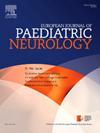Mid-to long-term disability and functional outcomes in pediatric patients with monophasic acute disseminated encephalomyelitis
IF 2.3
3区 医学
Q3 CLINICAL NEUROLOGY
引用次数: 0
Abstract
Background
Acute disseminated encephalomyelitis (ADEM) is a rare disease characterized by encephalopathy, polyfocal symptoms and demyelination. Although its prognosis is generally favorable, there is growing evidence that subtle neuropsychological and motoric sequelae may persist years after the initial episode.
Aim
To assess the relationship between clinical, laboratory and radiological characteristics of the acute monophasic ADEM episode in children, and its immediate outcome, and long(er) term disability/functional status.
Methods
Retrospective chart review embraced all children managed for monophasic ADEM over 18 years at a single tertiary center. They were invited for a follow-up medical, neurological assessment, and disability/functional outcomes assessment [modified Rankin scale (mRS), Extended Disability Status Scale and Functional Systems Scores (EDSS-FSS)].
Results
Of the 65 children (age 10–250 months, median 90; 46.2 % boys), 40 (61.5 %) were judged as fully recovered, and 25 had sequelae, two of whom (aged 23 and 13 months) suffered severe ocular or cortical symptoms. Follow-up assessment 21–211 months (median 154) after hospital discharge embraced 41 children, 27 discharged as recovered, 14 with sequelae. Of the latter, the two children with severe sequelae were seriously disabled with decrease in mentation, while 11/14 had mRS 0, and EDSS-FSS 0. Of the former, 7 had mRS = 1 and one had mRS = 2, whereas 5 had EDSS-FSS = 2, and 2 had EDSS-FSS = 3, including 2 children with mood alterations and 2 with mild decrease in mentation.
Conclusions
Unless truly severe, acute episode sequelae do not predict long-term disability/functional deficiency. Children recovered after the acute episode may have mild symptoms/deficiencies in long term.
儿童单相急性播散性脑脊髓炎患者的中长期残疾和功能结局
背景:急性播散性脑脊髓炎(ADEM)是一种罕见的疾病,以脑病、多灶性症状和脱髓鞘为特征。尽管其预后通常良好,但越来越多的证据表明,轻微的神经心理和运动后遗症可能在首发发作后持续数年。目的评估儿童急性单相ADEM发作的临床、实验室和影像学特征及其直接预后与长期残疾/功能状态之间的关系。方法回顾性回顾所有在单一三级中心治疗18年以上单相ADEM的儿童。他们被邀请进行随访医学、神经学评估和残疾/功能结局评估[修正兰金量表(mRS)、扩展残疾状态量表和功能系统评分(EDSS-FSS)]。结果65例患儿(年龄10-250个月,中位90个月,男孩占46.2%),40例(61.5%)完全康复,25例有后遗症,其中2例(年龄23个月和13个月)有严重的眼部或皮质症状。41例患儿出院后随访21-211个月(中位154个月),27例康复出院,14例有后遗症。其中2例严重后遗症患儿严重残疾,智力下降,11/14 mRS为0,EDSS-FSS为0。其中mRS = 1的有7例,mRS = 2的有1例,EDSS-FSS = 2的有5例,EDSS-FSS = 3的有2例,其中2例有情绪改变,2例有轻度的精神状态下降。结论非真正严重的急性发作后遗症不能预测长期残疾/功能缺陷。急性发作后恢复的儿童长期可能有轻微的症状/缺陷。
本文章由计算机程序翻译,如有差异,请以英文原文为准。
求助全文
约1分钟内获得全文
求助全文
来源期刊
CiteScore
6.30
自引率
3.20%
发文量
115
审稿时长
81 days
期刊介绍:
The European Journal of Paediatric Neurology is the Official Journal of the European Paediatric Neurology Society, successor to the long-established European Federation of Child Neurology Societies.
Under the guidance of a prestigious International editorial board, this multi-disciplinary journal publishes exciting clinical and experimental research in this rapidly expanding field. High quality papers written by leading experts encompass all the major diseases including epilepsy, movement disorders, neuromuscular disorders, neurodegenerative disorders and intellectual disability.
Other exciting highlights include articles on brain imaging and neonatal neurology, and the publication of regularly updated tables relating to the main groups of disorders.

 求助内容:
求助内容: 应助结果提醒方式:
应助结果提醒方式:


